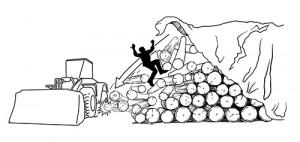BACKGROUND: On a cold, early spring morning in the Southeast, a log yard worker was removing a plastic tarp covering a stack of veneer logs that had recently been steamed prior to the log peeling process.
PERSONAL CHARACTERISTICS: The 20-year-old log yard worker had been working full-time for the company for a few years. When he was originally hired, he had received verbal instructions on his yard duties from the manager, in addition to instruction from other yard workers on how to apply the tarps and uncover the veneer logs.
UNSAFE ACTS & CONDITIONS: The yard worker exited the front-end loader he was operating and approached a pile of logs stacked 12 to 14 feet high. He removed some pieces of wood that were lying on top of the tarp and then climbed approximately 14 feet up to the top end to begin removing the tarp. Although this log stack had an end metal brace (approximately 10 feet by 10 feet) against which logs could be stacked to prevent them from rolling, post-accident investigation by the state OSHA agency discovered that the end logs had not been positioned against the metal upright brace.
ACCIDENT: While the victim was removing the plastic tarp and standing on the pile, some of the logs shifted, rolled down, and pinned the victim from his waist down.
INJURY: A saw operator noticed the partially uncovered log pile and observed that no logs had been moved to the veneer processing deck—this was probably within 15 minutes of the accident. He walked over to the area, and he found the victim, pinned and unconscious. The co-worker ran to get assistancefrom additional employees to rescue the pinned worker, and one employee called 911. When EMS arrivedapproximately 15 minutes later, the victim was not breathing and had no pulse. The medical examiner arrived shortly after that and pronounced the victim dead (due to crushing injuries and bleeding).
RECOMMENDATIONS FOR CORRECTION: The NIOSH Fatality Assessment and Control Evaluation (FACE) program report describing this incident made the following recommendations:
1. Employers should develop an engineering control measure to eliminate the hazards associated with the need to climb on stacked logs to apply or remove tarp coverings. (The employer has since built a concrete foundation with a permanent tarp cover on a fixed frame over each of the log steaming stacks, which eliminates the need for workers to climb the piles.) Additionally, companies can develop and utilize a yard safety checklist as part of its standard operating procedure.
2. Employers should ensure that logs are properly stacked, secured, and maintained in a manner that eliminates worker exposure to injury from logs falling or rolling from the stack.
3. Employers should develop, implement, and enforce a comprehensive occupational safety and health program and provide worker training that includes hazard recognition and the avoidance of unsafe conditions. Such training should include individual assessments to assure that workers are competent in the recognition of hazards and safe work practices, and the employer should document the content, dates, and names of employees completing the training.
 Courtesy of the Forest Resources Association: https://www.forestresources.org/page.asp?content=startpage&g=FRA
Courtesy of the Forest Resources Association: https://www.forestresources.org/page.asp?content=startpage&g=FRA
